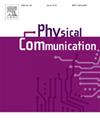PLS-RSMA system: An eavesdropping perspective
IF 2
4区 计算机科学
Q3 ENGINEERING, ELECTRICAL & ELECTRONIC
引用次数: 0
Abstract
This paper studies the physical layer security (PLS) of a rate-splitting multiple access (RSMA) system over Nakagami-m fading channels. Unlike existing works, we focus on the eavesdropper (Eve) perspective, considering both passive and active jamming scenarios due to the uncertainty of Eve behavior. For a fair comparison, we introduce the concept of effective power (EP) for the overall PLS-RSMA system. In the passive eavesdropping case, EP is equivalent to the transmit power at the base station (BS), whereas in the active jamming case, EP is defined as the power gap between the BS and Eve. Considering the effects on the EP and Eve location, closed-form expressions of the security outage probability (SOP) are respectively derived for both considered scenarios. Simulation results corroborate our analysis, indicating that when EP is lower or Eve is farther from the BS, the probability of Eve attacking legitimate users is higher. On the contrary, a closer Eve tends to wiretap information directly from the BS. These findings provide valuable insights for predicting and implementing effective protection mechanisms for the PLS-RSMA system.
PLS-RSMA 系统:窃听视角
本文研究了中上衰减信道上速率分割多路访问(RSMA)系统的物理层安全性(PLS)。与现有研究不同的是,由于夏娃行为的不确定性,我们将重点放在窃听者(夏娃)的角度,同时考虑被动和主动干扰场景。为了进行公平比较,我们为整个 PLS-RSMA 系统引入了有效功率 (EP) 的概念。在被动窃听情况下,EP 相当于基站 (BS) 的发射功率,而在主动干扰情况下,EP 被定义为 BS 与夏娃之间的功率差距。考虑到对 EP 和夏娃位置的影响,分别得出了两种情况下安全中断概率 (SOP) 的闭式表达式。仿真结果证实了我们的分析,表明当 EP 较低或 Eve 离 BS 较远时,Eve 攻击合法用户的概率较高。相反,距离较近的夏娃倾向于直接从 BS 窃听信息。这些发现为预测和实施 PLS-RSMA 系统的有效保护机制提供了宝贵的见解。
本文章由计算机程序翻译,如有差异,请以英文原文为准。
求助全文
约1分钟内获得全文
求助全文
来源期刊

Physical Communication
ENGINEERING, ELECTRICAL & ELECTRONICTELECO-TELECOMMUNICATIONS
CiteScore
5.00
自引率
9.10%
发文量
212
审稿时长
55 days
期刊介绍:
PHYCOM: Physical Communication is an international and archival journal providing complete coverage of all topics of interest to those involved in all aspects of physical layer communications. Theoretical research contributions presenting new techniques, concepts or analyses, applied contributions reporting on experiences and experiments, and tutorials are published.
Topics of interest include but are not limited to:
Physical layer issues of Wireless Local Area Networks, WiMAX, Wireless Mesh Networks, Sensor and Ad Hoc Networks, PCS Systems; Radio access protocols and algorithms for the physical layer; Spread Spectrum Communications; Channel Modeling; Detection and Estimation; Modulation and Coding; Multiplexing and Carrier Techniques; Broadband Wireless Communications; Wireless Personal Communications; Multi-user Detection; Signal Separation and Interference rejection: Multimedia Communications over Wireless; DSP Applications to Wireless Systems; Experimental and Prototype Results; Multiple Access Techniques; Space-time Processing; Synchronization Techniques; Error Control Techniques; Cryptography; Software Radios; Tracking; Resource Allocation and Inference Management; Multi-rate and Multi-carrier Communications; Cross layer Design and Optimization; Propagation and Channel Characterization; OFDM Systems; MIMO Systems; Ultra-Wideband Communications; Cognitive Radio System Architectures; Platforms and Hardware Implementations for the Support of Cognitive, Radio Systems; Cognitive Radio Resource Management and Dynamic Spectrum Sharing.
 求助内容:
求助内容: 应助结果提醒方式:
应助结果提醒方式:


